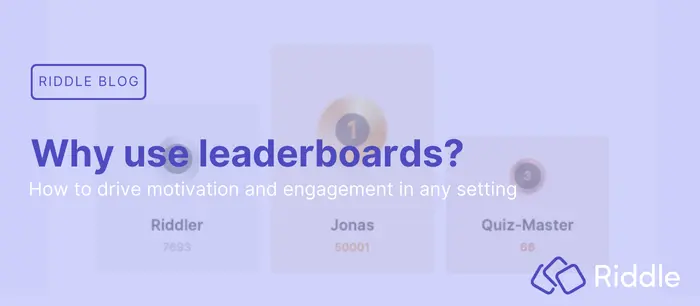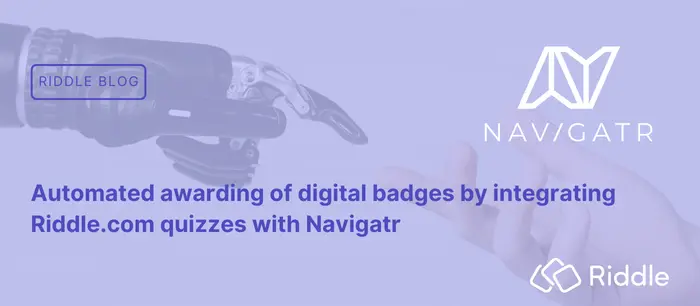How to drive motivation and engagement in any setting
Introduction
Leaderboards are the ultimate gamification add-on to quizzes and score predictors. They provide a sense of achievement and turn every quiz into a competition. Comparing your score with everyone else who took the quiz is much more satisfying for the quiz taker than simply knowing how well (or badly) you scored.
When you string multiple quizzes or score predictors together, you can increase retention by running a seasonal leaderboard. Your quiz takers will return to your website or app whenever they can to improve their rank.
Lastly, leaderboards make the perfect addition to any raffle or competition as they are perceived as fair. Everyone can see how the leading players scored and picking a winner at the end is easy.
The psychology and history behind leaderboards

Leaderboards had their place in games long before the world wide web. If you think back to old pin ball machines, they all had a leaderboard and you would spend money just to make it into the top three and then spend more money to stay there. The satisfaction and social status that comes with being at the top of a leaderboard will drive players to invest their time (and money) into the competition more than any other method.
The psychology behind the addictive and successful nature of leaderboards, particularly when combined with quizzes or score predictors, can be attributed to several key factors:
1. Competition and social comparison
Leaderboards inherently create a competitive environment, tapping into the innate human drive to compare performance, as described by Leon Festinger’s Social Comparison Theory. When people see how they rank against their peers, they are motivated to improve their performance to climb higher on the leaderboard.
2. Motivation and engagement
Leaderboards can significantly enhance user engagement by providing immediate feedback and rewards. The desire to see one’s name at the top of the leaderboard drives continuous participation. This competitive aspect can make quiz-taking even more of an exciting challenge.
3. Recognition and status
Reaching the top of a leaderboard offers a form of public recognition and status, which for many are sources of motivation. This idea of seeking validation for skills or knowledge is associated with self-esteem and self-actualization, both key components of Maslow’s hierarchy of needs.
4. Goal setting and achievement
Leaderboards provide tangible goals for users to strive towards. By setting a clear objective (e.g., reaching the top ten list), users are more likely to engage with the content repeatedly to meet these goals. In turn, achieving the goals then reinforces the behavior of taking part.
5. Gamification and enjoyment
Quizzes and score predictors are by their interactive nature already very engaging. Adding a leaderboard gamifies the experience, making it even more enjoyable. Gamification leverages game-design elements to enhance user experience and drive participation.
6. Positive feedback loops
Leaderboards create positive feedback loops by rewarding users with visual and numerical indicators of their success. This feedback can trigger the release of dopamine, a neurotransmitter associated with pleasure and reward, rewarding the activity and encouraging repeated participation.
7. Community and social interaction
Leaderboards foster a sense of community among participants. Knowing that others are taking part and competing creates a shared experience that can be motivating and fun. The social aspect of a leaderboard can enhance user retention and loyalty.
Leaderboards in marketing
Riddle.com leaderboards will help you get higher retention and traffic on your website, and increase engagement.
You can place a leaderboard outside the quiz or score predictor and encourage people to come back to check their position on the leaderboard frequently. The stand-alone leaderboard has a search box for users to find their unique username easily (if they don’t happen to be in the top spots on the leaderboard). Placing the leaderboard behind a user login or inside your app will also drive up your retention as people will keep coming back during the competition phase.
Example of a live leaderboard
Another idea for driving retention is to allow the audience to replay the quiz or predictor so that a player can try to beat their previous scores.
The biggest retention boost will be achieved by creating a seasonal competition where you link multiple Riddles to the same leaderboard. You can run competitions like “Quiz of the day” where you pick a winner each week, or a score predictor that covers an entire season. You can even combine quizzes and score predictors, and have both scores feed in to the leaderboard standing to make things more interesting.
Easy, password-less authentication through an email code ensures that users can continue to improve their scores and play with the same nickname each week.
Ongoing engagement with leaderboards will ultimately lead to brand recognition as well as customer loyalty, both crucial for your marketing department.
Take this quiz to enter your name in our leaderboard
Best practices for implementing leaderboards
Running leaderboards with Riddle score predictors is straightforward. The user with the best prediction will be at the top. You may end up with many people sharing the top spots for single games that have low scoring, such as hockey or soccer. To mix things up a little, therefore, consider adding a quiz or running a series of score predictors with a single leaderboard.
For quiz leaderboards, you have the chance turn every quiz into a fun competition. You will need to find the right balance between challenging yet not frustrating questions. Ideally, your questions will need a few seconds of hard thinking to be answered. The Riddle leaderboard can also account for the time it took to complete the quiz in addition to calculating the highest score. That way, you will be able to have a clear winner; a quiz with roughly eight to twelve questions will not have many people with the same answer time and the highest score. Quiz leaderboards work well for stand-alone Riddles as well as a whole series. If you want to increase your retention rates, consider running a series of quizzes, and crowning the winner of a daily quiz contest.
Summary
Leaderboards are a great way to challenge users, increase retention, and build customer loyalty. Consider separating your leaderboard from the actual quiz or predictor. You can embed the leaderboard on its own page and link to it using call-to-action buttons from your Riddle result page. That way, you will get your users to come back often to check their position and share the leaderboard page with their social network if they are on top.
Stringing together multiple Riddles to create a long-term leaderboard competition is a great way to get users to return to your app or website frequently. This feature is available in our free trial and Enterprise plan. The single Riddle leaderboard is available in all Riddle plans.
Further reading
Learn more about the psychology behind leaderboards and how to use them in your marketing strategy. Here is a collection of scientific and specialist articles about leaderboards and gamification:
- https://journals.plos.org/plosone/article?id=10.1371/journal.pone.0249283
- https://link.springer.com/article/10.1007/s10639-022-10983-z
- https://www.researchgate.net/publication/368357789_How_leaderboard_positions_shape_our_motivation_the_impact_of_competence_satisfaction_and_competence_frustration_on_motivation_in_a_gamified_crowdsourcing_task
- https://www.sciencedirect.com/science/article/abs/pii/S0747563215300868
- https://medium.com/practical-motivation-science/how-to-motivate-with-leaderboards-da5a461fb2f6
- https://www.eurogamer.net/the-pinball-arcade-review



